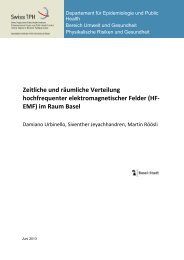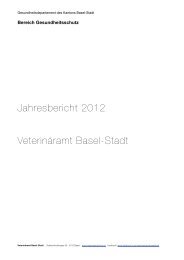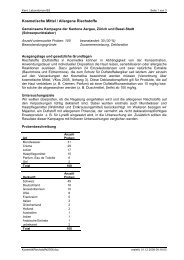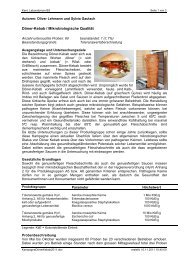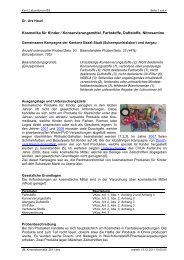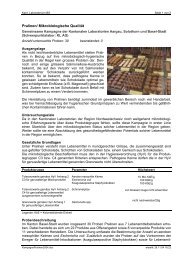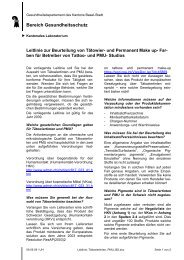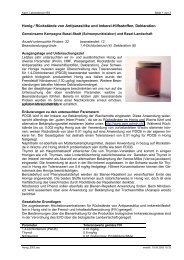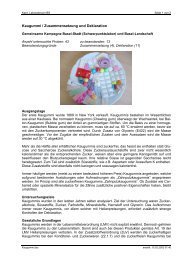Bericht als PDF herunterladen
Bericht als PDF herunterladen
Bericht als PDF herunterladen
You also want an ePaper? Increase the reach of your titles
YUMPU automatically turns print PDFs into web optimized ePapers that Google loves.
Kant. Laboratorium BS Page 2 of 4<br />
Sample description<br />
The samples were collected at customs (6 sets), and further samples were taken from stores in<br />
the Cantons of Aargau and Basel-City.<br />
Country of origin<br />
Number of sets<br />
(samples)<br />
Germany 7 (39)<br />
China 3 (14)<br />
Netherlands 2 (9)<br />
Malaysia 1 (8)<br />
France 1 (2)<br />
Total 14 (72)<br />
Test method<br />
Because of the broad scope of this investigation, a wide range of methods were used to test the<br />
finger paints:<br />
Parameter group<br />
Number of of which<br />
parameters permitted<br />
Methods<br />
UV-active preservatives 46 24 HPLC-DAD<br />
Isothiazolinones 3 2 HPLC-DAD<br />
Redox-active preservatives 3 3 HPLC-ECD<br />
Free formaldehyde 1 1 HPLC-DAD<br />
Quaternary ammonium compounds 15 8 HPTLC<br />
Iodopropynyl butylcarbamate (Screening) 1 1 HPLC-MS<br />
Bittering agents (Screening) 3 3 HPLC-MS<br />
Aromatic amines 33 - HPLC-MS<br />
Aromatic amines following reductive cleavage 29 - HPLC-MS<br />
Colouring agents (KLVD customs samples) approx. 100 - HPTLC and UV<br />
Results<br />
Preservatives<br />
• Three sets (19 paints) contained more than the permitted 15 mg/kg of methyl<br />
isothiazolinone/methylchloro isothiazolinone (MI/MCI). On the basis of the values found and<br />
the fact that particularly MCI is not stable, it can be concluded that the finger paints were<br />
originally preserved with between 30 and 60 mg/kg depending on the set. MI/MCI is known to<br />
be a potent allergen. Allergies to MI/MCI are particularly problematic as several cosmetics,<br />
every-day chemic<strong>als</strong> (for example starch sprays for ironing), as well as colourants and<br />
varnish are preserved with MI/MCI.<br />
• Furthermore, the following preservatives were found (number of sets affected shown in<br />
brackets). All concentrations were within the legal requirements.<br />
Phenoxyethanol (2), methyl- (8), ethyl- (1), propyl- (6), and butyl- (2) paraben,<br />
4-hydroxybenzoic acid [as degradation product of the parabens (2)], sorbic acid (3), o-<br />
phenylphenol (5), bronopol (3), free formaldehyde (6). Formaldehyde is not usually used<br />
directly but is released by several different preservatives, such as bronopol, diazolidinyl urea<br />
and imidazolidinyl urea.<br />
• No non-permitted preservatives were detected.<br />
Bittering agents<br />
According to EN 71/7, finger paints need to contain denatonium benzoate, saccharose<br />
octaacetate, or naringin as a bittering agent. A bittering agent (denatonium benzoate) was only<br />
detected in 7 of the sets. However, the LC-MS method, with a limit of detection of approximately<br />
25 µg/g, does not cover the whole activity range specified by the standard for denatonium<br />
benzoate (up to 4 µg/g). The concentration of denatonium benzoate in samples was generally<br />
between 100 and 300 µg/g. In those cases where no bittering agent was detected, the<br />
manufacturers were asked. The answers indicated that none of the samples contained the<br />
required bittering agent.<br />
Report0602.doc compiled: 25.01.06 07:31:00



